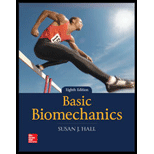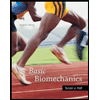
Concept explainers
The relative angle at the knee changes from 0° to 85° during the knee flexion phase of a squat exercise. If 10 complete squats are performed, what is the total angular distance and the total angular displacement undergone at the knee? (Provide answers in both degrees and radians.) (Answer: ϕ = 1700°, 29.7 rad; θ = 0)
To determine: The angular distance and angular displacement at the Knee.
Answer to Problem 1IP
The total angular distance for 10 squats is
Explanation of Solution
Calculation:
The angular distance knee must travel for flexion is
Write the expression for angular distance.
Substitute
Therefore, total angular distance for 10 squats is
Convert the total angular distance for 10 squats into radian.
Therefore, the total angular distance for 10 squats in radian is
There is no change in position after completing 10 squats, thus, angular displacement is zero.
Therefore, total angular distance for 10 squats is
Want to see more full solutions like this?
Chapter 11 Solutions
BASIC BIOMECHANICS
- If a person has a vertical force of 10.25N with a nylon strap of a 2.5cm of width and length of 10cm in the trapezius muscle, how much time does the person need to feel pain in the muscle? How much time is needed to injure or damage the muscle? Must show every mathematical process.arrow_forwardTwo lifter's knees are of interest at a specific moment in their lifts. In both lifts, the knee extensor torque is 100 Nm, requiring quadriceps tendon/patella ligament forces of 1000 N (about 220 Ibs). Despite equivalent knee torques and quadriceps forces, patellofemoral joint forces are higher on the knees of lifter A. Briefly explain why. Edit View Insert Format Tools Table 12pt v Paragraph v BIUAarrow_forwardHow much force must be produced by the biceps brachii, attaching at 90? to the radius at 3 cm from the center of rotation at the elbow joint, to support a weight of 200 N held in the hand at a distance of 30 cm from the elbow joint? (Neglect the weight of the forearm and hand, and neglect any action of other muscles)arrow_forward
- Before testing a true 1-RM exercise, why should you allow your client to complete 3 trial repetitions first? Select 2 correct answer(s) To reduce risk of injury To ensure form is correct To fatigue the muscles to a "normal" functional strength To focus on the eccentric and concentric portions of the movementarrow_forwardWhat is the type of intensity of this following exercise below. 1.) Mountain climber 2.) Leg raises 3.) Plant knee elbow 4.) Toe touchesarrow_forwardney: Load (L) = 5 kgs = Effort E = Fulcrum Weight of forearm = 1.8 kgs L = Load Biceps brachii muscle Distance of load from elbow joint = 35 cm %3D Effort (E) = contraction of biceps brachii Distance of center of mass of forearm from elbow = 17 cm Distance of tendon from elbow = 4 cm A) Draw the free-body diagram to represent the forces and moments Load (L) = weight of object plus forearm B) Write the torque equation for static equilibrium Fulcrum (F) = elbow jointarrow_forward
- Write the procedures of pickup the EMG signal to predicate the angle at the ankle jointarrow_forwardName the specific types of angular motion.arrow_forwardIf your biceps brachii muscle attaches to your forearm 2 inches below your elbow, the distance from the elbow to the palm of your hand is 18 inches, and you lift a 20 pound weight, how much pull must your muscle exert to achieve elbow flexion? If your biceps brachii muscle attaches to your forearm 2 inches below your elbow, the distance from the elbow to the palm of your hand is 18 inches, and you lift a 20 pound weight, how much pull must your muscle exert to achieve elbow flexion? hhharrow_forward
- Total compressive knee forces range between O 1-2 %BW O 2-4 %BW 3-5 %BW 0.5-1.5 %BWarrow_forwardmid arm muscle circumfrence is 22.95 using mid arm muscle circumfrence to determine the health status on a 22 years old male which is 170cm tall and 58.5 kgarrow_forwardA patient is completing a knee extension exercise. The patellar tendon inserts on the tibia 2.92 cm away from the knee joint axis of rotation. The foot is 40.38 cm away from the knee joint axis of rotation. What is the foots arc length through the exercise if the patellar tendon insertion moves through an arc length of 7.80 cm? Report you answer in meters.arrow_forward

 Basic BiomechanicsBioengineeringISBN:9780073522760Author:Susan J HallPublisher:McGraw-Hill Education
Basic BiomechanicsBioengineeringISBN:9780073522760Author:Susan J HallPublisher:McGraw-Hill Education

